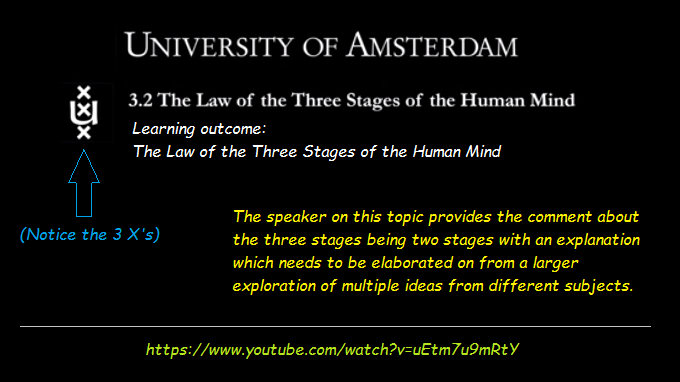pg 4
~ The Study of Threes ~
http://threesology.org
Researchers as of 12/16/2019
| Embellished Dichotomies Series | |||
| Page 1 | Page 2 | Page 3 | Page 4 |
The term "schizophrenia" was coined on April 24, 1908, when Professor Bleuler gave a lecture at a meeting of the German Psychiatric Association in Berlin. At that meeting, Professor Bleuler argued that (the then used common term of) dementia praecox was associated with neither dementia nor precociousness, and emphasized that splitting of psychic functioning is an essential feature of schizophrenia. One of the most striking differences between Emil Kraepelin and Bleuler is that Kraepelin collected information about his patients from their records while Bleuler obtained the information by careful clinical observations. He practically lived in the patients surroundings. Bleuler derived his concept from the Greek verb schizein, indicating splitting. The second part of the word goes back to the Greek phren, originally denoting 'diaphragm' but later changing to 'soul, spirit, mind'.
In 1911, Bleuler wrote "I call dementia praecox schizophrenia because, as I hope to show, the splitting of the different psychic functions is one of its most important features. In each case there is a more or less clear splitting of the psychological functions: as the disease becomes distinct, the personality loses its unity". He recognized that dementia was not a usual characteristic of dementia praecox, suggesting the term schizophrenia (splitting of the mind) for the disorder. Bleuler introduced the concept of primary and secondary schizophrenic symptoms; his four primary symptoms (the four As) were abnormal associations, autistic behavior and thinking, abnormal affect and ambivalence. The central symptoms of the illness are the loss of association between thought processes and emotion and behavior. In his view depending on the individual's adaptive capacity and environmental circumstances, this fundamental process could lead to secondary disease manifestations such as hallucinations, delusions, social withdrawal, and diminished drive.
Note: Bleuler's "4 A's" represent implied dichotomies:
- abnormal associations (versus presumed normal associations for a given time and place,
- autistic behavior and thinking (Can a person have one without the other? And that in discussing normality, it is readily understood and consciously advocated by some autistics that Normality is a social and cultural construct and hardly a human universal. Neurotypical Neurodivergent dichotomy)
- Autism acceptance – false dichotomies and the damage done One of the most prevalent false dichotomies, one that parents like me have been on the receiving end of a great number of times, is this: EITHER you believe that your child's autism is lifelong, a fundamental part of who your child is and therefore love and accept your child OR you are seeking interventions that might diminish or cure the autism symptoms, revealing that you don't believe that autism is necessarily lifelong or integral to who your child is and therefore you are unaccepting of your child, perhaps do not even love or deserve your child or see your child as fully human. The choices are love and acceptance OR treatments, representing something much less beautiful than love.
- abnormal affect (versus normal affect for a given time and place)
- Ambivalence Ambivalence is a state of having simultaneous conflicting reactions, beliefs, or feelings towards some object. Stated another way, ambivalence is the experience of having an attitude towards someone or something that contains both positively and negatively valenced components. The term also refers to situations where "mixed feelings" of a more general sort are experienced, or where a person experiences uncertainty or indecisiveness.
With respect to the work of Emil Kraepelin whose dichotomic concept of psychosis is the best-known part of his psychiatric work, and the objections which have been levied against what appears to be what I knee-jerkingly refer to as an old ideology, we have here a view which supports my inclinations due to the research into the threes phenomena: Rethinking psychosis: the disadvantages of a dichotomous classification now outweigh the advantages. We must ask why the usage of such a clinical orientation stood as the paramount perspective, if psychosis was never top-heavy, so-to-speak in its usage of a dichotomous frame work of a person's perception; or at least behavioral representation of perceptions and biological processes despite the presence of trichotomies both in the body and outside it in the larger world of information... though presumed "dichotomous" psychotics were not necessarily in an environmental (home, social, treatment) setting which afforded them the ability to come into contact with trichotomous experiences as I do? Why too, despite the view that in the: The persistence of dichotomies in the study of behavioral development by Timothy D Johnston, it is said: "The inadequacies of dichotomous views of behavioral development that oppose learned and innate behavior, or genetic and environmental determinants of behavior, have long been recognized.
Yet, we find another instance where the usage of dichotomization is proposed as and advancement in a given setting for a given task: The cost of dichotomising continuous variables by Douglas G Altman, professor of statistics in medicine and Patrick Royston, professor of statistics:
Measurements of continuous variables are made in all branches of medicine, aiding in the diagnosis and treatment of patients. In clinical practice it is helpful to label individuals as having or not having an attribute, such as being "hypertensive" or "obese" or having "high cholesterol," depending on the value of a continuous variable.
Categorisation of continuous variables is also common in clinical research, but here such simplicity is gained at some cost. Though grouping may help data presentation, notably in tables, categorisation is unnecessary for statistical analysis and it has some serious drawbacks. Here we consider the impact of converting continuous data to two groups (dichotomising), as this is the most common approach in clinical research...
In some perspectives you might encounter three ideas being represented in an overlapping pattern which asserts that three ideas, though they can be overlapped, nonetheless retain an individualized identity, as can also be displayed with a Venn diagram:
.
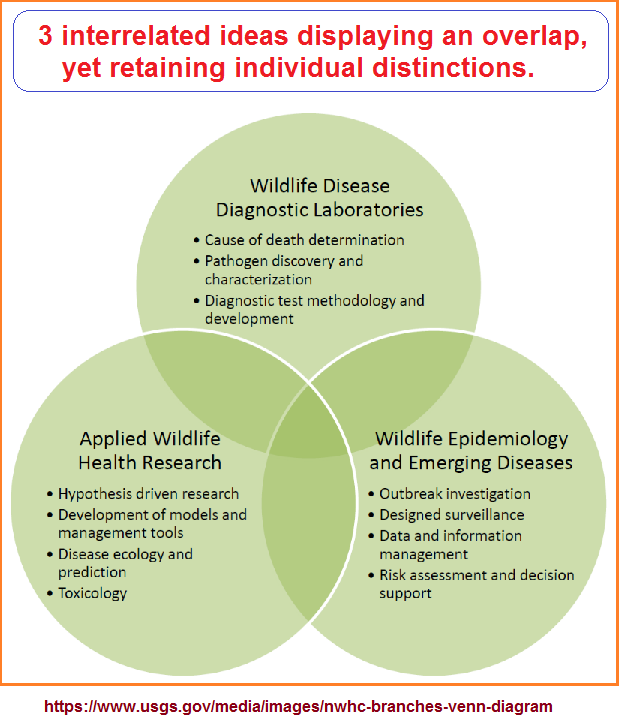
Let us also make the confession that though such ideas use words instead of numerical references and mathematical symbols, they nonetheless convey a mindset which can be expressed in mathematical terminology as a means of emphasizing the presence of an intended, if only an attempted expression of logic. (I repeat an image shown on the previous page):
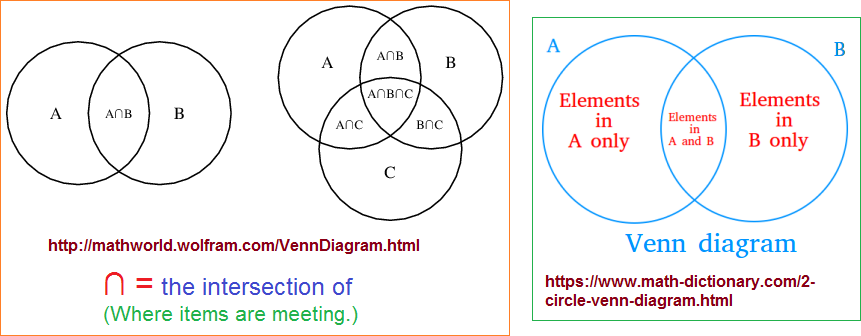
Since the brain is said to be comprised of electrical-like activity in its neurons, an analogy with basic electronic circuitry can be helpful, with an additional reference to the operations of a computer which are made possible utilizing very fast episodic movements of off and on switching, as displayed by the following three switches, the first illustrating the speed of switching by the usage of a person's hand, the second one imagined as a result of someone whose energy is accelerated by the caffeine in coffee or an energy drink, and the third as an example of a very slow computer:
 A common 'person speed' of switching. |
 After drinking coffee or an energy drink. |
 A very slow computer switching speed. |
Initial source: Let's Talk Peace page 8
Yet in using the electric switch as an idea which accurately, if by analogy, represents the "real world" not diffused by human senses, do we imply that there exists an overlap between positive and negative like the so-called "grey area" sometimes suggested for that which exists in a conditional state of being between right and wrong? Likewise, is a ground state used in electrical (alternating current) circuitry for homes and businesses to be described as a transitional stage between plus and minus or positive and negative, akin to the "middle ground" noted as the metaphysical in Aguste Comte's idea of a 3-step progression in thinking? Do positive and negative have a "middle ground" which marks a transitional "way station' as might be described in the 3-part sequence of Heaven- Purgatory- Hell or as some like to describe as Heaven- Purgatory- Earth? No less, one might suggest that such a transitional state occurs during those moments when the Earth's Magnetic field flip flops, only that the middle ground, the transition, the purgatory so-to-speak, is not as one might imagine to be a half-and-half equality; but something neither north and south, positive and negative or for that matter, right and wrong? Hence, is this unarmed, or "none" situation an actual third entity even if it is not labeled and not understood, if at all even a part of some peoples consciousness of consideration who can be affected by it nonetheless?
When speaking of the Earth's magnetic field we need also, in conjunction, to discuss an electric field by comparison: Electric Field versus Magnetic Field comparison chart
| Electric Field | Magnetic Field | |
|---|---|---|
| Nature | Created around electric charge | Created around moving electric charge and magnets |
| Units | Newton per coulomb, volts per meter | Gauss or Tesla |
| Force | Proportional to the electric charge | Proportional to charge and speed of electric charge |
| Movement In Electromagnetic field | Perpendicular to the magnetic field | Perpendicular to the electric field |
| Electromagnetic Field | Generates VARS (Capacitive) | Absorbs VARS (Inductive) |
| Pole | Monopole or Dipole | Dipole |
Electric Field vs. Magnetic Field
How do we determine overt and subtle effects on human thinking caused by the periodic reversals whose effects may create individualized and overlapping occasions which linger in different objects as well as places? Can differences in thinking be accounted for, in some instances by such effects? Can we align stagnant and/or salient events in history on the biological and sociological and psychological level due to magnetic/electric field changes? One must wonder if slight variations in mineral content of human bones/bodies can be affected differently, though present day means and methods of detection are not sensitive enough to give us reliable data.
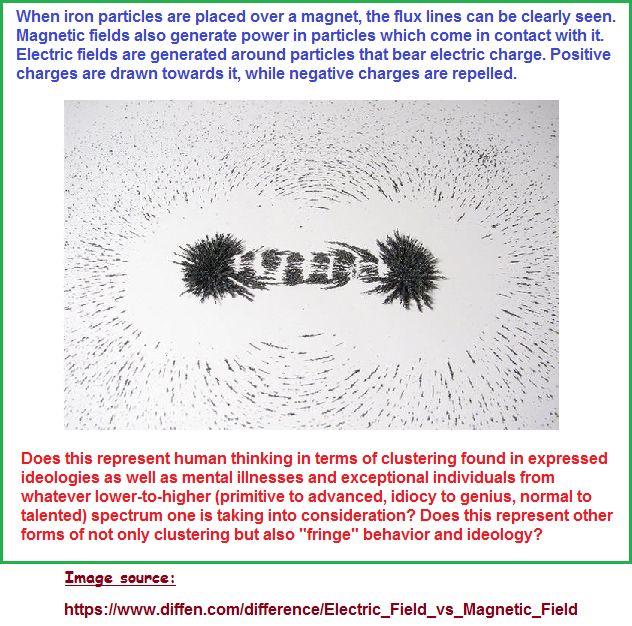
A basic electric circuit that we can use to illustrate an analogy to the idea of the brain's electrical impulses from which are derived patterns of thought we come to decipher as a pattern-of-two, three, four, etc..., is the on/off characteristic that we might alternatively describe as positive and negative; with the negative being alternatively labeled the ground in a Direct current application such as most automobiles (though there have been positive ground varieties); and in an Alternating Current application seen in most homes and businesses as the adopted standard world-wide, we find that the old positive/negative, or plus/minus has become attached with a three-wire ensemble as a standard basic circuit with the third wire being indicated as a grounding mechanism so as to prevent an electrical shock, thereby effectively adding a type of fusible link into the system. The "fusible link" is an idea commonly used in automobile applications:
An electrical fusible link is a type of electrical fuse that is constructed simply with a short piece of wire typically four American wire gauge sizes smaller than the wire that is being protected. For example, an AWG 16 fusible link might be used to protect AWG 12 wiring. Electrical fusible links are common in high-current automotive applications. The wire in an electrical fusible link is encased in high-temperature fire-resistant insulation to reduce hazards when the wire melts.
Yet, in the same article above, we find the mention of another type of fusible link, thus giving an option between two... as might be described as a pattern-of-two, thus giving us a mechanical and electrical variation but no chemical to render the situation wherein we can find a solid- liquid- gas ensemble.
A mechanical fusible link is a device consisting of two strips of metal soldered together with a fusible alloy that is designed to melt at a specific temperature, thus allowing the two pieces to separate. Mechanical fusible links are utilized as the triggering device in fire sprinkler systems and mechanical automatic door release mechanisms that close fire doors in warehouses, etc. Some high-security safes also utilize fusible link-based relockers as a defense against torches and heat-producing tools. Mechanical fusible links come in a variety of designs and different temperature ratings.
Wikipedia: Fusible Link
Fuses are a two-pronged, or double-ended device by which a single line of current or potential current can be interrupted, such as in the case of an overload of too much energy, which is an idea (with this terminology) not often applied in the case of human behavior; while there exist other devices which redirect current along a singular path that might well diverge towards multiple other paths. No less, these other devices such as a transform-er can be used to boost or decrease the level of voltage or amperage for given applications.

Typically in an automobile, the positive wire is always red and the black wire is always the ground, thus making what can be imagined as a circular run between the positive (plus or "hot") and negative (minus... sides of the battery. (Although the plus is also sometimes referred to as the "hot" or power side, the negative is rarely if ever referred to as the "cold" side but we can say it is just for the sake of conversation. In a house circuit, the colors of the wires is red for the hot side, and black is called the neutral wire which completes the "roundish" return of power in the circuit, and the third ground wire in a basic setup is reserved for three different colors: A green, green with a yellow stripe, or bare copper wire. Solved! What 12 Different Electrical Wire Colors Actually Mean. Again: Two-prong vs three-prong outlet: What’s the difference? The main difference between a two-prong outlet and a three-prong outlet is that a three-prong outlet has a ground wire, while a two-prong outlet doesn't. A ground wire is basically a wire that acts as a shortcut and directs any surge of excess electricity to safely flow into the ground.
Articles that may be of perusal interest:
- A Brief History of Home Electrical Wiring By Timothy Thiele
- Wikipedia: Electrical wiring in North America
- Wikipedia: Electrical wiring (Examples from other countries are listed).
A reason to insert the examples of electrical conductivity is to ask whether those who prefer to use a "two-patterned" idea are those who like to be involved with Direct Current applications of thought, so-to-speak; and those that use what we assume to be three-patterned ideas are those who are inclined towards a type of Alternating form of conceptualization, and thus use a type of "grounding" wire?
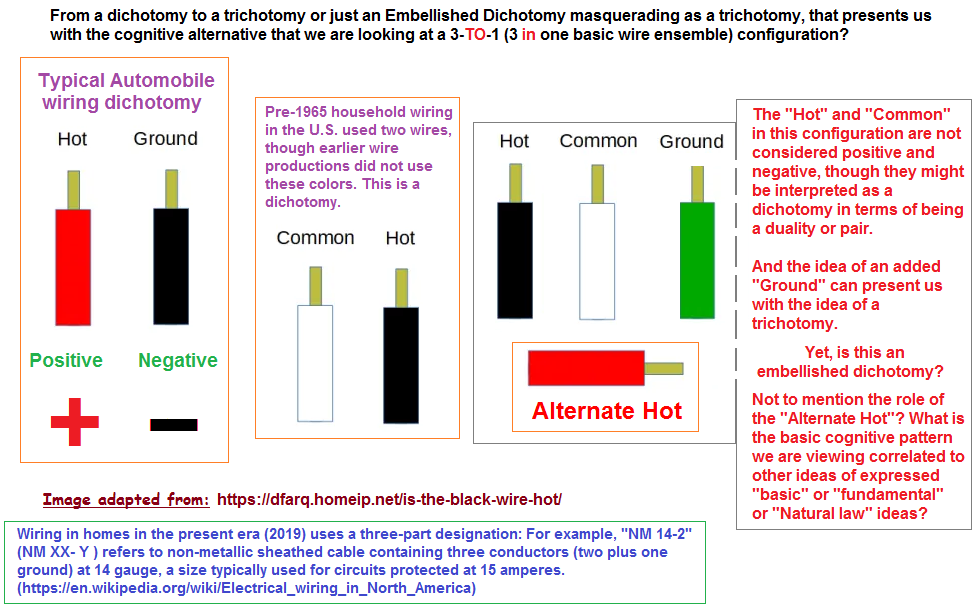
With respect to embellished dichotomies, wherein a third item gives someone the interpretation they are dealing with not three separate entities but two and that an overlap between the two is described as a third; yet their observation and readjusted labeling does not adequately explain why someone would want to describe an overlap as a separate third entity in the first place. If the overlap is easily recognized as a mixture of two, why then describe it as three? What is influencing the impulse to use such a method of labeling? Is this a form of one-up-man-ship, or is there an unrecognized inclination to grow, to evolve, to "best" (be better than or alternative to) that which when enumerated, suggests a lower-than-desired level? While we might want to describe this inclination as being Natural, is this in-our-nature behavior due to the environment we are in, or is it part of an underlying biological theme which is itself influenced by an environment exhibiting this pattern and biology merely mimics its surroundings?
If we claim that many, most or all patterns-of-three are little more than embellished dichotomies, then can we not also claim that a dichotomy, however we label it (duality, double, two, companion, opposites, partner, opposition, etc.), are little more than embellished singularities? Is the two actually two separate entities or simply a reflection, a mirror image of a singularity that we label as a duality, dichotomy, etc? Since we identify this mirror-imaging in biology as noted by the term bilateralism, but that bilateralism is one-of-three basic forms of symmetry (Bilateral- None- Radial), to which we might also add alternative orientations such as three body types (Ectomorph- Mesomorph- Endomorph), the three-in-one person Freudian distinctions of (Id- Ego- Superego), and a host of other three-patterned ideas which may or may not readily transcribe into the present discussion of an embellished dichotomy, if for no other reason than we simply have not taken the time, or that such a distinction is not warranted in multiple cases, though it is in others. And this says nothing about the presence of 3 stop codons juxtaposed next to the presence of 1 start codons in DNA, or the 3 basic 3-in-1 situation of fats-carbohydrates-proteins, or the 3-to-1 characterization of solid-liquid-gas/plasma configuration, or the 3 laws of planetary motion, or the 3 basic rock formations, or the use of three fingers to hold a pen or pencil, or the multiple threes occurring in language and hearing, or the upper-middle-lower social classes... to give but a miniscule representation of items needed to be considered in an attempted suggestion that a given three-patterned idea is actually a two-patterned idea.
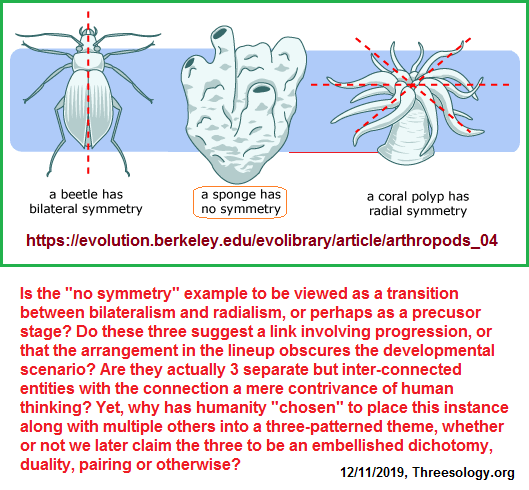
Bilateral (left/right) symmetry
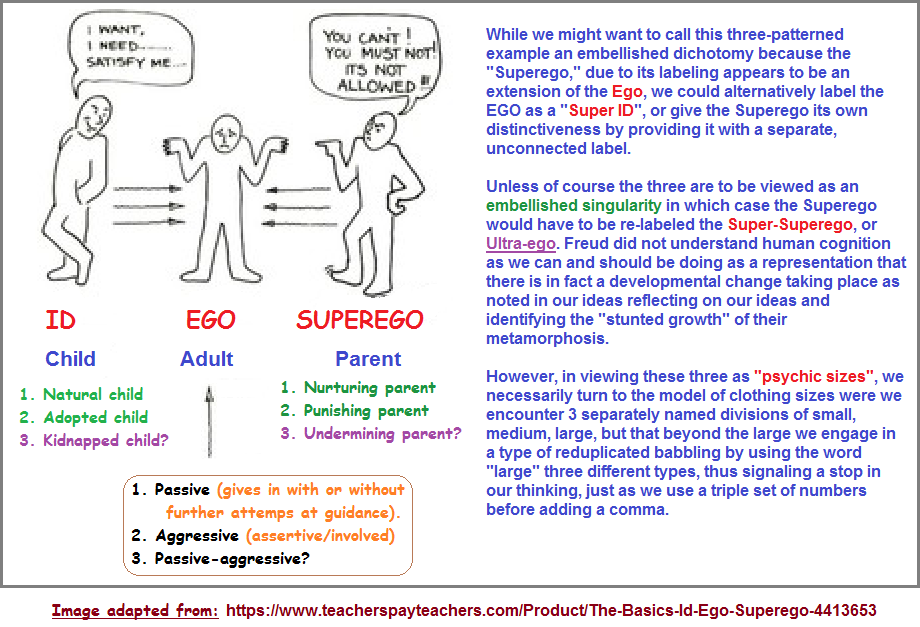
If we prefer to say that some instances of three-patterned ideas actually reflect an "embellished dichotomy", then will we also dare to consider that the human mind is trying to achieve a three-patterned orientation but something prevents it from developing an actual representation, and thus will argue for what they believe to be is the presence of an actual "three" but is an actual two in yearning for a three-state of being? Yet, why is this so? Is there some environmentally influenced atomic and genetic inspired orientation in this direction, and that a stunted or incomplete metamorphosis to an actual full blown or fully winged "three" has some underlying stop in place, like the 3 stop codons found in genetics... as opposed to only one start codon?
Is being on the 3rd planet from a source of solar energy an actual "3rd" or a representative model of an embellished dichotomy that we are having difficulty perceiving though the concept of twin stars (binary star systems) is widely known, but not yet applied to the circumstances under which humanity has evolved or now lives and is unable to achieve an adequate distance from in order to be more objective about their current conditions?
Changes from some point in the past to a future point, particularly if the one or more changes becomes fixed as an observable re-occurring fixture; are sometimes defined as a development that might be alternatively described as an evolution, mutation, growth, etc., for good or ill. Because different changes take place, or at least the interpretation of observations if not only the wording used to describe a given observation; a person may come to then suggest or even declare that such a development, such a growth, or development and growth or evolution are an imperative... when there may be no such imperative, even though a particular change or changes take place on a given schedule, such as the birth and death of a person. If we use the terms birth and death as a dichotomy, then one might claim that all that which occurs between these two is merely an embellishment of them, though the "embellishment" may well be portrayed in terms of a growth on one end and a disintegration on the other end, and the disintegration, like the growing incidence of genetic mutations such as Down's Syndrome, might come to be subjected to terms to ease the misgivings of consciousness whereby instead of calling them retarded, they are said to be "challenged" in one respect or another, though the presented challenges are "artificialized" constructs created by a given era in which the mutated person is born into.
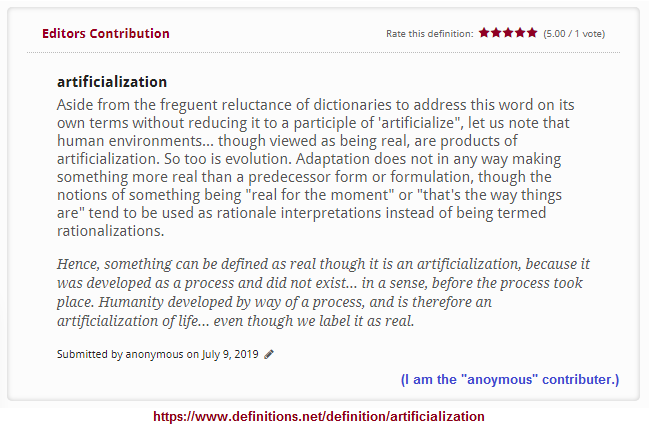
Definitions and Translations
If we assert as some do that a pattern-of-two defines reality such as described by the Yin and Yang ideology, the South Korean adoption of the three-part Yin- Unity- Yang may well be interpreted to not be an actual "three" distinction of separateness, but an expressed embellished dichotomy. The "Blending" of two does not create a third, but expresses the cognitive desire for a third, as if a metamorphosis of consciousness has a sense of a developmental scenario, but can neither instigate it or actually achieve it. Then again, we must ask what is stunting the development to a "full bloom" or "full winged" expression, unless something is constraining that development... such as an incrementally deteriorating environment which forces development to achieve and then maintain that level of equilibrium best suited for the reality of the deterioration, and not the reality that is possible to achieve if given the opportunity to thrive in an unrestricted environment. This being said, we must then look upon all businesses, governments and religions as part of the rationale which assists the environment in constraining the development of humanity beyond its many dichotomous ideas and practices; because it is their adopted rationale which serves their immediate self interests of survival by way of exploitation the configuration of constraints in the present environment.
Taking a look at esoteric ideas as well as main-stream ideas, we find that as described in the Masonic Sun and Moon: by Richard Cassaro:
- Freemasonry’s Number Three is said to be a Balance Of Opposites.
- In Freemasonry, the Triangle expresses the number Three and the Three-In-One in geometric form. The Triangle stands not only for the Doctrine of Duality, but also the Third power that balances duality.
While Freemason holds the number three as having an especial relevance, and recognize duality with a balancing act, as well as the idea of a 3-in-one characterization, it has not progressed to embracing the idea that many of the ideas which are embraced as a secret and powerful formula, if not having some Cosmological significance; which also denotes the idea of an "embellished dichotomy" being displayed as an interrupted, abrupted, or otherwise stunted growth of and actual three construct.
If we look at the three standardized College degrees of Bachelor's, Master's, PhD and claim them to not be three separate degrees but that the Master's is an embellishment of the Bachelor's and the PhD is an embellishment of the Master's, are we not also describing the situation that the PhD is an extended form of Bachelor's degree embellishment? If so, then have we not described a 3-in-1 configuration which is an illustrated representation of the effects of the slowing Earth and Sun's three-phases fusion? Are we also, by extension, then to argue that the belief in Hinduism of three separate entities Labeled as Brahma- Vishnu- Siva are actually successive embellishments of a singular cognitive formula that is camouflaged by the elaborations of language to suggest to the unaware there are three who are merely dressed up in different costumes and placed into alternative sceneries to give the impression of a 3-part multiplicity indicating a desire for something to represent a wish for progressive cognitive development which can not be achieved so long as humanity remains in an incrementally deteriorating environment? And the same holds true for the Christian Trinity and the supposed triads of Religious deities who are so named by present day observations of an increased interest in the "three" yet those in the past may not have actually counted such deities in the same manner with the same "triad" orientation?
Does an increased usage of three-patterned ideas suggest an increased... albeit unrealized desire for a cognitive growth, whereby dichotomies become refashioned to fill the void that is presented by the many dichotomies, thus creating a third entity in a sort of one-up-man-ship exercise that is itself sometimes subjected to different formulas of one-up-man-ship whereby fours, fives, sixes, sevens, eights, nines, tens, etc... and multiples of the three or the others, comes to be presented; and yet all of which merely represent a desire to push forward beyond the environmental constraints of duality imposed on biology?
Whereas the reader can see the two-wire system changing to a three and multiples thereof leading to a 3-to-1 configuration as shown previously, they may not be familiar with the basic patterns found in Genetics, that for example, display a double helix, a triplet code, and a 3-to-1 configuration in that when looking at both RNA and DNA, we find there are 3 amino acids the same (Adenosine- Cytosine- Guanine) and 1 amino acid which is different: RNA has Uracil and DNA has Thymine, though two amino acids pair with one another and there exists 3 stop codons with 1 start codon. And yet, if we claim that evolution is an imperative, then why hasn't the triplet code evolved from so many billions of years ago... unless there is an environmental constraint in place. Something that is unrecognized as yet is keeping the triplet code as the standard code, like the same cookie cutter being used again and again and again... like some autistic person becoming entranced (captivated) by viewing the clothes spinning in a front loading dryer with a glass door. Is the supposed god an autistic? If evolution is an imperative, are we describing an evolution caught up in an incrementally deteriorating environment which, like a washing machine, may reverse course as that revealed by the flip-flop of the Earth's geomagnetic field?
If we are to claim that some three-patterned ideas are "embellished dichotomies", then let us do so without embarrassment or reluctance to call the kettle both black and hot, without trying to distract anyone by focusing on the concocted brew which may be filled with a specialized pharmacy of intent to create a condition of inebriation so that recognized or unconscious ulterior motives can be fulfilled. Let us so name those three-patterned ideas which come across as a two-patterned view and formally label them as an "embellished dichotomy", which thus presents us with a third term that may or may not itself be viewed as an expressed embellishment of the two-versus-three controversy, whether or not it is labeled a dichotomy.
As a Threesologist studying the phenomena of "threes", I don't want to be in a position that is viewed sometime in the future as that of a person who refused to acknowledge a given three-patterned portrayal as not being an actual three, or even that I would not give a voice to the possibility that a given three could be an embellished dichotomy. I want to be remembered as having tried to define and underline the idea that not all "threes" examples are actually threes, though they do display a threes ensemblage; and that instead came to recognize that something appears to be stunting the development from a two to a three, if an enlarged three presence is actually possible and instead we are faced with two-patterned ideas masquerading as three-patterned ideas because our brains, our minds, our biology has an inherited inclination to follow a 1-2-3 development course but something is constraining us to create rationales which persuade us to think that such has been achieved. Like a person who is smart enough to convince themselves to believe in a particular religion, business model, political practice or even suicide, yet not cognizant enough to realize they are smart enough to not think in such as well. Whereas we come to convince ourselves that a given three-patterned idea best fits as the model representing all the data, all the ideas, we do not always seek to play our own Devil's advocate to consider alternatives. Sometimes we are too impulsive and consider a supposed "Eureka" occurring idea is the best fit, only because it is within the parameters of the particular considerations, and not an enlarged setting or enlarged application.
Origination date: Monday, December 2nd, 2019... 5:47 AM
pg 3
~ The Study of Threes ~
http://threesology.org

Researchers as of 12/16/2019
| Embellished Dichotomies Series | |||
| Page 1 | Page 2 | Page 3 | Page 4 |
In an attempted explanation of the "Embellished Dichotomies" idea, let us take for example the 3-part idea of progressive thinking proposed by Auguste Comte with his from Religion- through the Metaphysical- into a Scientific view scenario. The "Metaphysical" is sometimes viewed as a transitional phase between the first and third item and is thus considered by some not to be an actual second and distinct phase, but expresses a period of overlap between two polar positions, as one might describe with a Venn diagram used as a model in describing other ideas as well:
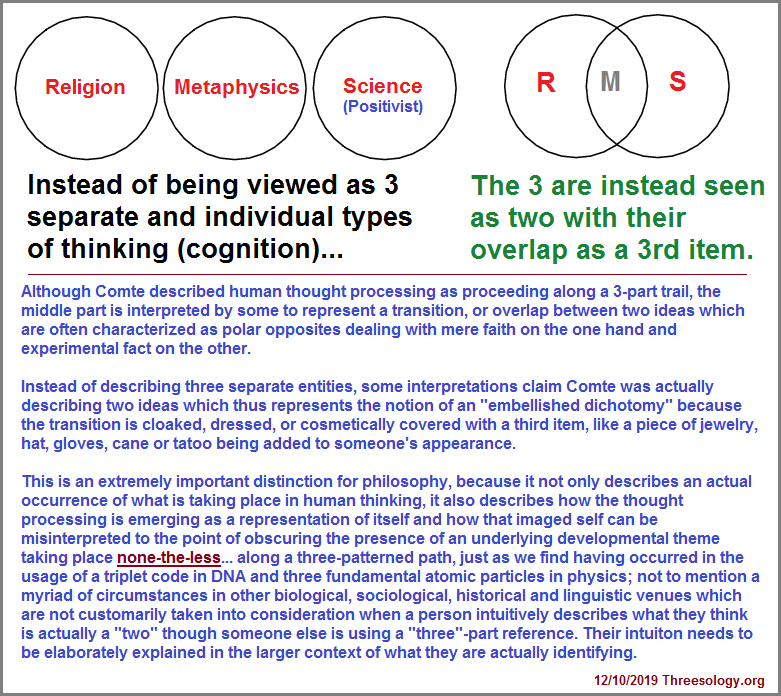

Let me provide the script for the first image since translating mechanisms used by internet sources are unable to translate words on images, and math illustrations often speak for themselves since the language of math is generally universal:
Although Comte described human thought processing as proceeding along a 3-part trail, the middle part is interpreted by some to represent a transition, or overlap between two ideas which are often characterized as polar opposites dealing with mere faith on the one hand and experimental fact on the other.
Instead of describing three separate entities, some interpretations claim Comte was actually describing two ideas which thus represents the notion of an "embellished dichotomy" because the transition is cloaked, dressed, or cosmetically covered with a third item, like a piece of jewelry, hat, gloves, cane or tattoo being added to someone's appearance.
I must confess that although I have mentioned the idea of "embellished dichotomies" before, it was not until I watched the following youtube presentation that I feel prompted to provide an elaboration of the represented idea suggesting Comte's 3-part idea to be only two elements:
(Note: I had left a comment about the speaker representing what I describe as an embellished dichotomy and provided a link to this website in order to present multiple "threes" which are not being considered as part of the "Three being a Two", but my comment was removed. Very often when I raise an objection to those who think they have a grasp of the "three", my comments are removed or never show up because they are dismissed by some pre-review process.
In addition to Comte, let me provide a short reference about the usage of a suggested tripartite progressive order which preceded Comte, and may have had some influence on his own idea:
In terms of the tripartite ensemble of Mysticism- Rationalism- Empiricism; René Descartes is given credit by way of his "postulate of three classifications for our ideas when he says: "Among my ideas, some appear to be innate, some to be adventitious, and others to have been invented by me." Wikipedia: Rationalism (Rene Descartes
Three ancient Greek philosophers had a profound affect on later Sociological thinking: (Slide #s 6, 7, 8)
- Socrates (469–399 B.C.E.) formulated idea of the Socratic method is a form of cooperative argumentative dialogue between individuals, based on asking and answering questions to stimulate critical thinking and to draw out ideas and underlying presuppositions.
- Plato (429?–347 B.C.E.) Plato was the first western philosopher who attempted a systematic study of society. Plato in republic and Aristotle in Politics dealt systematically with social institutions. They accepted state and society as synonymous and took the individual for granted. Plato could be said to be the first exponent of the organic theory in society and Aristotle subscribed to it too. Thus they accepted society as a unified system structured around division of labor and social inequality. Sociology guide: Plato
- Aristotle (384–322 B.C.E.) He is noted as being a student and follower of Plato. Aristotle was more practical in his beliefs of government and society, whereas Plato was more idealistic and utopian. Aristotle and his students used the "Socratic method" to explore social issues, religion, politics, education the rights and duties of citizenship, and the relationship between the individual and the larger society. slide # 8
Note: Decades ago when I saw the "SPA" signs of health/exercise clubs, they stood as the initials for the idea that Socrates taught Plato who taught Aristotle who taught Alexander the Great. He had three major battles against the Persian Empire; those three battles were the battle of Granicus, the battle of Issus, and lastly the battle of Gaugamela. The Macedonian Conquest of Persia.
Herbert Spencer (1820 - 1903) viewed societies as living organisms. In his First Principles, he describes three principles which regulate the universe: namely the Law of the Persistence of Force, the Law of the Instability of the Homogeneous and the Law of the Multiplicity of Effects.
Emile Durkheim 15 April 1858 – 15 November 1917: Throughout his career, Durkheim was concerned primarily with three goals.
- First, to establish sociology as a new academic discipline.
- Second, to analyse how societies could maintain their integrity and coherence in the modern era, when things such as shared religious and ethnic background could no longer be assumed; to that end he wrote much about the effect of laws, religion, education and similar forces on society and social integration.
- Lastly, Durkheim was concerned with the practical implications of scientific knowledge.
The importance of social integration is expressed throughout Durkheim's work:
For if society lacks the unity that derives from the fact that the relationships between its parts are exactly regulated, that unity resulting from the harmonious articulation of its various functions assured by effective discipline and if, in addition, society lacks the unity based upon the commitment of men's wills to a common objective, then it is no more than a pile of sand that the least jolt or the slightest puff will suffice to scatter.
—Émile Durkheim-
And here's a comment the source for which escapes me at the moment:
They saw society in holistic terms and gave state the dominant role. Aristotle thought the origin of societies lay in human nature and its structure consisted of social groups in function. Their views presented the definition of society in terms of objective laws and historical processes.
Unfortunately, the word "Sociology" is often construed to mean a study of groups and not Society as an expressed element of human cognition. The "social" gets people bogged down in minutiae, against which many women strive to find self-help books to assist them in getting rid of the inclination to be bothered with little, small, insignificant things which create needless bothersome orientations which create distractions from reaching larger goals. The sensitivities of many women (but not just women) are often exhibited in their interest for subtleties of perception sometimes creating divergent paths of interest which some women claim are only accessible with a female psyche. In any respect, the study of Sociology... when subjected to the "little things" orientation of some females creates stumblings blocks of being able to see a larger picture.
It is of need to pay witness to the developmental roots of Sociological thought since there are numerous instances where ideological concepts become placed into various three-part ensembles such as the traditioned "Upper- Middle -Lower" classes that some view as three distinctions but others might well look at as a 3-in-1 entity involving transitional overlappings which produce dichotomies such as the rich versus poor, educated versus un-educated, villians versus workers, ("villains" or vilein/vilain were once contrasted with worker in older sociological thinking, because some villagers were seen as rabble rousers against the status quo... to give but one interpretation.)
The landed aristocracy (those at home in villas in the classical Latin sense of the word) dominating medieval society in the days of Middle English had all the power, politically and linguistically, and under their use of the word, the Middle English descendant of villanus meaning "villager" (a word styled as vilain or vilein) developed the meaning "a person of uncouth mind and manners." As the common equating of manners with morals gained in strength and currency, the connotations worsened, so that the modern word villain is no unpolished villager, but is instead (among other things) a deliberate scoundrel or criminal.
The History of the Word 'Villain'
- Villians, Victims, and Heroes in Character Theory and Affect Control Theory
- Heroes, Villains and Fools, as Agents of Social Control
- Emile Durkheim (15 April 1858 – 15 November 1917) His three-part deviance theory.
- Pitirim Sorokin (January 21, 1889 — February 10, 1968) Sorokin's work addressed three major theories: social differentiation, social stratification and social conflict.
Here is an expressed exercise of the "Embellished Dichotomy" idea put into practice. One must laugh at the effort to reach a third position by way of using a contrasting dichotomy which makes the scheme yet another dichotomy!
- Middle-range theory (sociology) Middle-range theory, developed by Robert K. Merton (4 July 1910 – 23 February 2003), is an approach to sociological theorizing aimed at integrating theory and empirical research. It is currently the de facto dominant approach to sociological theory construction, especially in the United States. Middle-range theory starts with an empirical phenomenon (as opposed to a broad abstract entity like the social system) and abstracts from it to create general statements that can be verified by data. This approach stands in contrast to the earlier "grand" theorizing of social theory, such as functionalism and many conflict theories. Raymond Boudon has argued that "middle-range" theory is the same concept that most other sciences simply call "theory".
- Wikipedia: Sociology Emile Durkheim, Karl Marx, and the German theorist Max Weber (1864–1920) are typically cited as the three principal architects of sociology.
- Social Groups: Dyad and Triad & In-Groups and Out-Groups
- Dichotomy: In and Out social group (examples without suggested transitional placements between, thus giving a primary- secondary- tertiary)
- Us versus Them
- Comrade versus enemy
- Franchised versus Disenfrachised
- Belong versus Outcast
- Togetherness versus Aloneness
- Trichotomy: (includes a "two")
- Dyad social group
- Triad social group
- Beyond the three social group
The study of triads and dyads (Sociology) was pioneered by German sociologist Georg Simmel (1 March 1858 – 26 September 1918) at the end of the nineteenth century.
As we see in the labeled counting system of primitive peoples developing words for quantities, there is a word for One, a word for Two, and anything beyond the Two is labeled many, much, more or even a few. Nonetheless, this is a three-ensemble related to human cognition. Each successive quantity can be viewed as an embellishment of the lesser quantity before it, like the doubling of cells during cellular development. We might suggest that cells are trying to grow beyond their repeating two's programming, yet can only achieve an embellishment in the form of differentiation along another line of development for some other physiological function that also uses an "embellished dichotomy" formula. Something is preventing the repetition from going beyond itself to establish an actual "three", and then when it does under the current environmental/social/physical conditions, it results in a trisomy... or mutation that is not very viable as as self-sufficient organism. While there are polysomic events, the idea of stunted growth or development is understood by a mention of the trisomic condition.
In the early years of anthropology, the prevailing view of anthropologists and other scholars was that culture generally develops (or evolves) in a uniform and progressive manner. The Evolutionists, building upon the success of Darwin’s theory of evolution, but not drawing much inspiration from his central contribution of the concept of natural selection, sought to track the development of culture through time. Just as species were thought to evolve into increasing complex forms, so too were cultures thought to progress from simple to complex states. Initially it was thought by many scholars that most societies pass through the same or similar series of stages to arrive, ultimately, at a common end. Change was thought to originate principally from within the culture, so development was thought to be internally determined.
The evolutionary progression of societies had been accepted by some since the Enlightenment. Both French and Scottish social and moral philosophers were using evolutionary schemes during the 18th century. Among these was Montesquieu, who proposed an evolutionary scheme consisting of three stages:
- Hunting or savagery
- Herding or barbarism
- Civilization
To the above let us add a bit of history of the French Revolution which came to inspire Auguste Comte's ideas:
- The Old Regime – society before the revolution was basically divided into three estates based on class and rank (to which let us also pay tribute to the three divisions of social labor in the Middle Ages (customarily divided into Early, High and late) which preceded this, which were Apprentice- Journeyman- Master):
- Church – clergy which owned 10% of the land, paid no tax
- Nobles – 2% of the population, owned 20% of the land, 70% of wealth
- Third Estate – everyone else
French Revolution
It was the 3rd estate which came to comprise the three divisions of Radicals- Moderates- Conservatives as the French Revolution got more fully under way, and used the tripartite slogan of "Liberty- Fraternity- Equality"; coming to refer to each other as "citizen" as a means of enfranchising themselves as a person who mattered and could not be degraded nor humiliated by the other two estates of Clergy and Nobles.
This tripartite division became very popular among the 19th century social theorists, with figures such as Tylor and Morgan adopting one or another version of this scheme (Seymour-Smith 1986:105).
Social Evolutionism by Heather Long and Kelly ChakovThis is an extremely important distinction for philosophy, because it not only describes an actual occurrence of what is taking place in human thinking, it also describes how the thought processing is emerging as a representation of itself and how that imaged self can be misinterpreted to the point of obscuring the presence of an underlying developmental theme taking place none-the-less... along a three-patterned path, just as we find having occurred in the usage of a triplet code in DNA and three fundamental atomic particles in physics; not to mention a myriad of circumstances in other biological, sociological, historical and linguistic venues which are not customarily taken into consideration when a person intuitively describes what they think is actually a "two" though someone else is using a "three"-part reference. Their intuition needs to be elaborately explained in the larger context of what they are actually identifying.
This is the labeling used for a Categorical Syllogism: Major premise- Minor premise- Conclusion According to a google originated wikipedia preface for syllogism while using google and typing in "major premise, minor premise, conclusion" as one's sought for topic, this three-part ensembled is defined as:
Each of the premises has one term in common with the conclusion:
- In a major premise, this is the major term (i.e., the predicate of the conclusion).
- In a minor premise, this is the minor term (i.e., the subject of the conclusion).
Are we thus describing an embellished dichotomy masquerading as a trichotomy that never actually achieves an actual three-part independence or growth, because the mindset behind its development and continued usage is an expression of a stunted growth that has merely mutated into different forms of elaboration to give the impression of an achieved trichotomy that does not and can never exist because it is logistically bad code? Is it just another model of the rock- paper- scissors ensemble which stumbles over itself like the three stooges?
Hence, let us ask if they must be related in order to form a three-part structure such as this (idea of a syllogism), or can they be unrelated as one might generalize by using the three-part ensemble of "Asians- Africans- Caucasians", though each of these terms can be related in various ways, even when there has been much fighting amongst them. If we say they must be related, then are we describing non-separate entities and have come upon a practice of embellishment? Whereas this page is about the idea of embellished dichotomies, we can also include notions of embellished singularities and embellished triples, etc.
Some ideas that might otherwise represent and actual three-part representation may be caught up being in an inebriated "under the influence" state of environmental circumstances that created conditions of stunted growth in ideas, along with other permutations akin to the biological idea of mutation, which I believe to be transitioning towards a 3-in-1 coalescence, and there is nothing humanity can do about it, except for perhaps leave the planet, the solar system, and the galaxy, which would necessarily entail the development of a different type of species because of the havoc space travel will have on genetics.
In a discussion of philosophy as the primary topic of consideration, that is when advancing a tripartite configuration such as the syllogism, I should also provide some examples of "twoness", as a means of providing an account of how often and varied a dichotomous mindset comes into play while attempting to provide some third valuation, of which need to be contrasted with alternatives if existing:
- Double-consciousness is a concept in social philosophy referring, originally, to a source of inward "twoness" putatively experienced by African-Americans because of their racialized oppression and disvaluation in a white-dominated society.
- Triple Consciousness: The Reimagination of Black Female Identities in Contemporary American Culture (by Nahum Welang) Abstract: My article underscores the intermediate existence of black American women between race and gender by stressing the role white patriarchy and black hypermasculinity play in the marginalisation of black female voices and the prioritisation of white women’s interests within and beyond mainstream feminist spaces. In order to legitimise this intermediate existence of black women, my article develops the triple consciousness theory (TCT).
- The doctrine (or principle) of double effect is often invoked to explain the permissibility of an action that causes a serious harm, such as the death of a human being, as a side effect of promoting some good end. According to the principle of double effect, sometimes it is permissible to cause a harm as a side effect (or "double effect") of bringing about a good result even though it would not be permissible to cause such a harm as a means to bringing about the same good end.
- The Doctrine of Triple Effect from Chapters 1 & 4 of Intricate Ethics (2007) by Frances Kamm ... Because of this third type of relation between an act and its effects—acting because the effects will occur, though not intending that they occur—it might be more inclusive to adopt what I call the Doctrine of Triple Effect (DTE).
- In the philosophy of mind, double-aspect theory is the view that the mental and the physical are two aspects of, or perspectives on, the same substance. It is also called dual-aspect monism. The theory's relationship to neutral monism is ill-defined, but one proffered distinction says that whereas neutral monism allows the context of a given group of neutral elements to determine whether the group is mental, physical, both, or neither, double-aspect theory requires the mental and the physical to be inseparable and mutually irreducible (though distinct).
Triple-aspect monism: physiological, mental unconscious and conscious aspects of brain activity. (by Pereira A Jr)
Abstract: Brain activity contains three fundamental aspects:
- The physiological aspect, covering all kinds of processes that involve matter and/or energy;
- The mental unconscious aspect, consisting of dynamical patterns (i.e., frequency, amplitude and phase-modulated waves) embodied in neural activity. These patterns are variously operated (transmitted, stored, combined, matched, amplified, erased, etc), forming cognitive and emotional unconscious processes.
- The mental conscious aspect, consisting of feelings experienced in the first-person perspective and cognitive functions grounded in feelings, as memory formation, selection of the focus of attention, voluntary behavior, aesthetical appraisal and ethical judgment.
Triple-aspect monism (TAM) is a philosophical theory that provides a model of the relation of the three aspects. Spatially distributed neuronal dendritic potentials generate amplitude-modulated waveforms transmitted to the extracellular medium and adjacent astrocytes, prompting the formation of large waves in the astrocyte network, which are claimed to both integrate distributed information and instantiate feelings. According to the valence of the feeling, the large wave feeds back on neuronal synapses, modulating (reinforcing or depressing) cognitive and behavioral functions.
- Neutral monism is a monistic metaphysics. It holds that ultimate reality is all of one kind. To this extent neutral monism is in agreement with the more familiar versions of monism: idealism and materialism. What distinguishes neutral monism from its monistic rivals is the claim that the intrinsic nature of ultimate reality is neither mental nor physical. This negative claim also captures the idea of neutrality: being intrinsically neither mental nor physical in nature ultimate reality is said to be neutral between the two.
- Double-truth theory, in philosophy, the view that religion and philosophy, as separate sources of knowledge, might arrive at contradictory truths without detriment to either—a position attributed to Averroës and the Latin Averroists. Perhaps neither Averroës, a Muslim philosopher, nor the Christian Scholastics influenced by his philosophy actually held such a theory. Averroës did believe in freeing philosophy from religion but held that truths of reason might also be expressed symbolically in religion. Where reconciliation seemed impossible, some of his followers gave authority to reason, others to faith.
The three most widely accepted contemporary theories of truth are:
- The Correspondence Theory;
- The Semantic Theory of Tarski and Davidson;
- The Deflation Theory of Frege and Ramsey.
The two competing theories are:
- The Coherence Theory
- The Pragmatic Theory
- ...While the literary double often centers on questions about the self, the double in philosophical writings manifests at the level of rhetoric, confirming Protagora's dictum that "on every question there are two opposing answers, Including this one."... The Poetics of Shadows: The Double in Literature and Philosophy
On the topic of the double as seen in some literary accounts, only a few need be offered as an example of dichotomies which by way of the literary account of time, place, characters, language, events..., comes to embellish the underlying dichotomy:
- A tale of two cities: A 1859 historical novel by Charles Dickens.
- Strange Case of Dr Jekyll and Mr Hyde: a gothic novella by Scottish author Robert Louis Stevenson, first published in 1886.
- Prince and the Pauper
Along with the idea of "Embellished Dichotomies" let us note those who have thought they are inventively trail blazing in their efforts to surpass the typical dichotomous viewpoint, such as: Transcending Dichotomies in History and Religion by C. T. MCintire
ABSTRACT
At first glance, to speak of "history and religion" presents no problem. We merely identify two items to discuss in the same study. We quickly discover, however, that since at least the twentieth century the pair "history and religion" has tended to operate as a dichotomy. Within the dominant traditions of discourse originating in Europe, over many centuries, the verbal pair "history and religion" became a dichotomy encoded as the dichotomy "secular and religious," signifying the opposition "not religious and religious." This dichotomy does not usually appear alone, but commonly comes associated with other dichotomies whose terms align with either history or religion. The short list of associated dichotomies includes: temporal and spiritual, natural and supernatural, reason and faith, public and private, social and personal, scientific and theological, objective and subjective, rational and emotional, and modern and medieval. The opposing parts come gendered as masculine and feminine. Usage of the dichotomies creates tensions with practitioners of virtually all religions in all regions of the world. Rigorous and consistent users of the dichotomies misunderstand the character of religions as ways of life, fail to account for the persistence and revival of religion in the twenty-first century, and overlook the intrinsic manner in which history manifests religion and religion manifests history. The defective outcomes prompt a number of constructive suggestions for transcending dichotomies in history and religion. These reflections on dichotomies refer to several varieties of Christianity, the emergence of the secular option, and the imagined triumph of Hindu dharma.
Let us also take into consideration, though multiple perspectives about which exist, concerning The Evolution of Transcendence by Gregory Gorelik, though the idea in this formulation may be little more than an embellished dichotomy itself.
Abstract
The transcendent experience, often described as an ego-dissolving encounter with something greater than one’s self, is cross-cultural and pan-historical. I present a model describing the evolution and function of various evolved modes of transcendence, such as group-directed transcendence, theory of mind (ToM)-evoking transcendence, aesthetic transcendence, and epistemic transcendence. I then discuss the vulnerability of these modes of transcendence to costly exploitation by selfish individuals who activate the transcendent state in others for their own reproductive benefit. In the ensuing section, I discuss the relationship between transcendence and human development across the lifespan, and conclude with some thoughts on the epistemic and ethical utility of transcendence.
...There is something to be said for occasionally shutting off all of the distractions that bombard the individual in modern society. From the automatic siphoning of one’s attention to radio and satellite signals, to the everyday commitments to one’s family, friends, and society at large, our environments are overflowing with manipulative influences. By engaging in meditation or some other transcendence-inducing practice, perhaps individuals can avoid being swayed by toothpaste advertisements and political propaganda (note Davidson and Lutz’s 2008, discussion of meditation’s efficacy in promoting attention and reducing distraction). As recounted by Huxley in The Perennial Philosophy (1970/1945; pp. 125–146), mystics from a variety of religious traditions and historical epochs were skeptical of the power of language and reason to communicate certain truths that can only be revealed by a direct encounter with what Buddhists call tathata or "suchness." I would counter that the apparent opposition between reason and more intuitive forms of knowing is a false dichotomy. Assuming that the ability to reason was selected because it enabled our ancestors to win arguments, the utility of transcendent experiences may be their capacity to dissolve illusory arguments, words, and appearances. Such a dissolving effect may, in turn, prepare the mind for the acceptance of better, more truthful forms of knowledge, be it in the form of non-exploitative arguments or experiences of suchness. Alongside self-correcting institutions based on peer review and the dialectic process, perhaps transcendent states might help us to drill down to some deeper truth hidden beneath the veneer of our evolutionarily limited everyday sensory experience. The revelations derived from such transcendent states should not be viewed as substitutes for evidence and reason, but as forms of knowledge that complement reason by clearing the fallacious residue surrounding it and supplement it by revealing states of consciousness beyond the humdrum of everyday experience. For example, the self-dissolving aspect of transcendence is supported by neuroscientific and psychological research on the absence of an encapsulated, unitary self (Kurzban 2010). The multidimensional nature of psychological selfhood, discovered by ancient mystics and contemplatives, is therefore a more accurate model of the mind than the Cartesian dualism still influencing academic philosophy (Dennett 1991, pp. 101–138).
it should be noted that the idea of "transcending the dichotomy" is an often used term to describe viewpoints where numerous conflicting (as opposed to harmonious complementarity) dichotomies are named. For example: Transcending the dichotomy of/in:
- Work and leisure by Primeau LA
- "Subpersonalities" or "An Integrated Unitary Self" by Victor Bogart, April 1, 1994
- Abraham Maslow; Dichotomy-transcendence: (acceptance, resolution, integration, or transcendence of dichotomies, polarities, opposites, contradictions); synergy (i.e., transformation of oppositions into unities, of antagonists into collaborating or mutually enhancing partners). (Positioned as a subcontext under wholeness.)
- Right and Wrong by Orin Davis, Nov 18, 2017
- Transcending unsustainable dichotomies in management: Lessons from Sustainability-Oriented Hybrid Organisations in Barcelona by Dina Hest, J. David Tàbara, Thomas F.Thornton,
- Psychosomatic symptoms as biomarkers: Transcending the psyche-soma (mind/body) dichotomy by Yair Neuman, PhD
- "Discourse Analysis Matters – Bridging Frameworks"; Dialogue Matters: Transcending Dichotomies by Ruth Wodak
- Process enhancement versus community building: Transcending the dichotomy through expansive learning by Yrjö Engeström
- Engaging, transcending and subverting dichotomies: Discursive dynamics of Maputo''s urban space by Bjørn Enge Bertelsen, Inge Tvedten, Sandra Roque (2014)
- ranscending the Secular-Religious Dichotomy: The AKP and the Blurred Edges of Politics and Religion in Turkey by European Consortium for Political Research
In logic, the semantic principle (or law) of bivalence states that every declarative sentence expressing a proposition (of a theory under inspection) has exactly one truth value, either true or false. A logic satisfying this principle is called a two-valued logic or bivalent logic.
In formal logic, the principle of bivalence becomes a property that a semantics may or may not possess. It is not the same as the law of excluded middle, however, and a semantics may satisfy that law without being bivalent.
The principle of bivalence is studied in philosophical logic to address the question of which natural-language statements have a well-defined truth value. Sentences which predict events in the future, and sentences which seem open to interpretation, are particularly difficult for philosophers who hold that the principle of bivalence applies to all declarative natural-language statements. Many-valued logics formalize ideas that a realistic characterization of the notion of consequence requires the admissibility of premises which, owing to vagueness, temporal or quantum indeterminacy, or reference-failure, cannot be considered classically bivalent. Reference failures can also be addressed by free logics.
The principle of bivalence is related to the law of excluded middle though the latter is a syntactic expression of the language of a logic of the form "P ∨ ¬P". The difference between the principle and the law is important because there are logics which validate the law but which do not validate the principle. For example, the three-valued Logic of Paradox (LP) (Paraconsistent Logic) validates the law of excluded middle, but not the law of non-contradiction, ¬(P ∧ ¬P), and its intended semantics is not bivalent. In classical two-valued logic both the law of excluded middle and the law of non-contradiction hold.
Many modern logic programming systems replace the law of the excluded middle with the concept of negation as failure. The programmer may wish to add the law of the excluded middle by explicitly asserting it as true; however, it is not assumed a priori.
The intended semantics of classical logic is bivalent, but this is not true of every semantics for classical logic. In Boolean-valued semantics (for classical propositional logic), the truth values are the elements of an arbitrary Boolean algebra, "true" corresponds to the maximal element of the algebra, and "false" corresponds to the minimal element. Intermediate elements of the algebra correspond to truth values other than "true" and "false". The principle of bivalence holds only when the Boolean algebra is taken to be the two-element algebra, which has no intermediate elements.
Assigning Boolean semantics to classical predicate calculus requires that the model be a complete Boolean algebra because the universal quantifier maps to the infimum operation, and the existential quantifier maps to the supremum; this is called a Boolean-valued model. All finite Boolean algebras are complete.
Also see: Bivalence, Excluded Middle and Non Contradiction by Jean-Yves Béziau
- Double Negation In propositional logic, double negation is the theorem that states that "If a statement is true, then it is not the case that the statement is not true."
A double negative is a grammatical construction occurring when two forms of negation are used in the same sentence. Multiple negation is the more general term referring to the occurrence of more than one negative in a clause. In some languages, double negatives cancel one another and produce an affirmative; in other languages, doubled negatives intensify the negation. Languages where multiple negatives affirm each other are said to have negative concord or emphatic negation. Portuguese, Persian, Russian, Spanish, Neapolitan, Italian, Bulgarian, Czech, Polish, Afrikaans, Hebrew, Ukrainian, and some dialects of English, such as African-American Vernacular English, are examples of negative-concord languages, while Latin and German do not have negative concord. It is cross-linguistically observed that negative-concord languages are more common than those without.
Example: "I haven't never owed nothing to no one."
- Triple Negation We define the logical connective negation and prove that a triple negated proposition implies a single negated proposition.
- Realism Versus Idealism by Mike Christison: At some point in time you have probably been taught that there is a difference between a realist and an idealist. There are two chief understandings of this perceived dichotomy. The common usage is a description of human behavior, often seen an explanation for political decisions. This is dependent upon the second philosophical usage, however, which largely denotes an epistemic stance. My argument is that the philosophical version is a false dichotomy, and as a result, the common version is not a very useful mental construct.
- Doppelgänger A doppelgänger), literally "double-goer") is a non-biologically related look-alike or double of a living person, sometimes portrayed as a ghostly or paranormal phenomenon and usually seen as a harbinger of bad luck. Other traditions and stories equate a doppelgänger with an evil twin. In modern times, the term twin stranger is occasionally used. The word "doppelgänger" is often used in a more general and neutral sense, and in slang, to describe any person who physically resembles another person.
- Three faces of Eve A triple ganger representation?
In psychology, we find multiple dichotomies and must review this in terms of a recurring instance of Persistent Dichotomies representing the sane, and those dichotomous profiles of what some may term insanity (depending on the era of occurrence), while others may refer to in terms which make allowance for characteristics that are not common, at least to their knowledge and experience. Such dichotomies are:
- Bipolar Disorder Bipolar disorder, also known as manic/depressive illness, is a brain disorder that causes unusual shifts in mood, energy, activity levels, and the ability to carry out day-to-day tasks.
- Medical Definition Of Split Personality Split personality: Multiple personality disorder, is a neurosis in which the personality becomes dissociated into two or more distinct parts each of which becomes dominant and controls behavior from time to time to the exclusion of the other parts.
- Schizophrenia: "Splitting of the Mind" Revisited Paul Eugen Bleuler coined the term "schizophrenia" to capture the fragmentation and disintegration of the mind and behavior as the essence of the disorder. The splitting of thoughts, feelings, and actions was duly noted, but very few studies over the past century have addressed how and why these functions are dissociated in schizophrenia. Despite the robust evidence for the influence of emotion on cognition and vice versa), the nature of these interactions and their role in psychotic symptoms are not clearly elucidated.
Origination date: Monday, December 2nd, 2019... 5:47 AM
Initial Posting: Monday, December 16th, 2019... 12:44 PM
Herb O. Buckland
herbobuckland@hotmail.com
Herb O. Buckland
herbobuckland@hotmail.com
